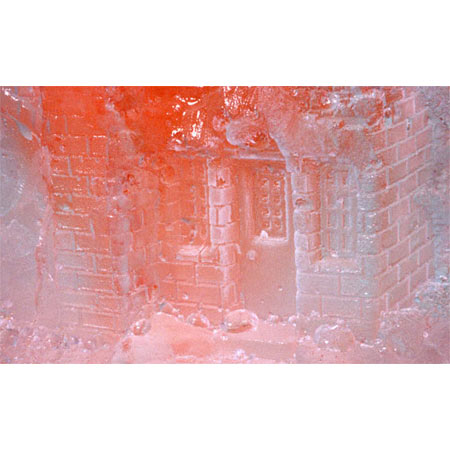
By now it can’t be news to anyone but the most determinedly insulated minds that the polar ice caps and glaciers across the globe are melting. Fast. Call it climate change or global warming, the reasons remain openly contentious. But that lack of causal certainty only means this month’s meeting of world governments in Copenhagen gathered to debate and weigh the scientific evidence and economic results of human action and inaction must be considered a sign of the spreading concern regarding the planet’s ongoing meltdown.
It is that political and psychologically charged backdrop which heats up the icy images and scientific looking objects in “Melting Point.” It informs and softens the stark, flowing currents of energetic black and white line captured in Bill Brody’s large scaled, meticulously detailed woodblock prints of curving Alaskan glaciers from his home state. His images, so much like oversized 19th century lithographs of majestic landscapes, feel timeless. But that sense of permanence is tempered immediately by our awareness that their real majesty may even now be dissolving.
Global crisis awareness also permeates George Geyer and Tom McMillin’s striking documentation of their elaborate phenomenological installation “Climate Extremes.” It adds an aura of scientific tutorial to their colorful images of a heated walkway terminating in the simple, formal beauty of a structure where ice forms on a copper cone only to drip onto a hot disc, sending up little clouds of steam.
The debate on global warming also adds a level of incisive irony to Margaret Pezalla’s massive paper sculpture simulating the bottom of an iceberg. Flat on top, it’s an inverted mountain of a form suspended in space. Made of cut, folded and taped together bristol board, her fragile but still solid iceberg is significantly based mostly on conjecture. It’s an underwater, hidden form that she imagined from datum but, like the rising oceans, has never actually seen for herself. In this age of scientific study and dissent her methods and materials echo beautifully.
Parodying the element of denial that surrounds the climate debate, moon walks and other kinds of scientific evidence, Michael Davis presents an amusing live video feed, “Icecapmelt”. Using a miniature globe whirling in front of a painted night sky he offers his own fake images of a heating planet as the unstable ‘proof’ of the unreliability of scientific evidence.
It is the general psychology of uncertainty and instability engendered by the current debate on the environment that informs Greta Waller’s absorbing paintings of glistening ice chunks. They sit like smooth, clear hunks of gem stone in different household and laboratory trays. Clearly melting, their very permanence in paint is essentially at odds with ice’s transitory nature. Within that discontinuity we catch ourselves wondering if the images can endure against the arctic ice’s slow dissolve.
But if the disappearance of glaciers and ice caps is an issue of global survival, the cycle of freeze, melt and mist is also essential and fundamentally beautiful. So while we wonder if what we are seeing in the slippery looking grey photographs of Iceland by Rebeca Mendez is simply seasonal or something more, we are still moved by their solitude. Mineko Grimmer’s sound sculpture parlays the physical act of ice decay into a sense of expectation and delight. Angie Bray’s photographs of rust colored frozen fields emerging from a tattered lacework of ice try to unfix the exact moment of melt within the steady progress of the transitory.
Some of the works in the show wring meaning from the simple physical reality of ice. Richard Carter’s dark paintings of icebergs floating off the coast of American cities are suspended like silent monoliths of cosmic travel and displacement. Daniel Du Plessis’ oil painting of a yellow rose encased in icicles locks away the vitality of life, just as Tal Yizrael’s intensely colored photographs make cast ice houses and cars too visually beautiful to feel urgent. Marshall Astor reposits ice as an element of Norse mythology. Victor Raphael sanctifies yet dismisses glaciers that took millennia to grow by turning them into instant Polaroids haloed by gold leaf skies.
Art may not be able to stem the tide of global glacial melt or verify its causes. But it does provide welcome opportunities like this to elicit visual thoughts and consider what it might mean to lose our planetary cool.
Published courtesy of ArtScene ©2009
